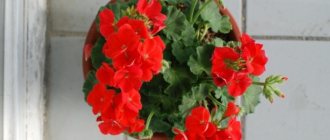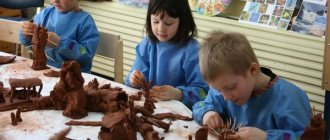Flowers for kindergarten
The child spends most of the day in kindergarten.
Therefore, it is natural that parents want it to be cozy and comfortable there, just like at home. Indoor plants can help with this. In addition to aesthetic pleasure, flowers in kindergarten also bring practical benefits . They perfectly clean the air of dust and toxic substances. The phytoncides that some green “pets” secrete have bactericidal properties.
Scientists have proven that in a room where there are indoor plants, the number of harmful microorganisms is halved. Plants increase the level of air humidity, which is especially important during the heating season.
In addition, representatives of indoor flora have a positive effect on the mental and emotional health of children, bring joy, and relieve fatigue. It’s also an opportunity to get acquainted with the world around us, learn how to care for plants, and develop responsibility and kindness.
However, despite all the advantages of having indoor flowers in a kindergarten, not every one of them is suitable for this institution.
Bulbous cunning
there is a simple remedy
It is safer to store planting material separately from daffodil products
Snowdrop (Galanthus nivalis)
Very poisonous; in traditional medicine it is used to produce potent drugs used in neurology, but traditional medicine does not use this plant due to the high risk of poisoning in case of overdose. Snowdrop bulbs and fruits are dangerous, the consumption of which can cause nausea and vomiting, and in severe cases, serious kidney damage.
Snowdrops are highly poisonous. Photo by Samdolis (Svetlana)
Narcissus
The bulbs are poisonous; the alkaloid lycorine they contain stimulates the vomiting center in the brain, so a “pleasant” pastime after tasting daffodils is guaranteed.
It is not advisable to taste daffodil bulbs
The best plants
- Chlorophytum - is a rosette of leaves with “mustaches”, at the ends of which there are small “babies”. The plant is unpretentious, recovers quickly, and tolerates irregular watering. Perfectly purifies the air from bacteria, viruses and exhaust gases;
- Crassula, or Crassula, is a fast-growing tree-like plant with fleshy, glossy leaves. Broken cuttings can be used for propagation. Unpretentious. Helps improve performance;
- Fern - has a lush, beautiful appearance. Grows quickly and recovers easily. Undemanding in care, can grow in partial shade. Helps cope with stress and relieve fatigue, improves concentration;
- Citrus fruits are beautiful trees that can grow both in the shade and in the light. They contain many essential oils that have bactericidal properties and neutralize harmful microorganisms. Citrus fruits also cope well with fatigue, eliminate irritability, calm and improve sleep;
- Hamedorea graceful is an ornamental deciduous plant similar to a palm tree. Unpretentious, can grow in partial shade. Excellent air humidification. Purifies the air by eliminating hazardous substances released by plastics;
- Hibiscus, or Chinese rose, is a shrub that can grow in partial shade. The stems are elastic and resistant to damage. Hibiscus has well-defined stems, leaves and bright flowers, which will help children study the structure of plants;
- Tradescantia is an ampelous plant that can be hung in a flower pot. Undemanding to watering and lighting. Perfectly humidifies and purifies indoor air. It is distinguished by its ability to neutralize electromagnetic radiation;
- Kalanchoe - secretes phytoncides that neutralize fungi and bacteria. It has medicinal properties: anti-inflammatory, wound healing. Helps with cough, runny nose, flu, furunculosis;
- Schefflera is a beautiful decorative deciduous unpretentious plant. It perfectly purifies the air from harmful substances present in cigarette smoke, such as nicotine and various tars.
DECIS
Place No. 10: DECIS is a contact-intestinal insecticide that belongs to the group of synthetic peritricides. Used to protect various crops from a variety of pests. Contains a high concentration of the active ingredient deltamethrin - 250 g/l. The objects of its influence are aphids, psyllids, leafhoppers, whiteflies, scale insects, bark beetles, weevils, weevils, Colorado potato beetles, beetles, grain borers, moths, and codling moths. The advantages of the drug are high efficiency at low dosages, moderate danger to humans and animals, and safety for the soil. Decis is compatible with almost all growth stimulants, fungicides, and insecticides. Exceptions are alkaline products, for example, Bordeaux mixture.
Thus, each product is original in its properties, the chemical active substance on the basis of which it is made, or the biological mechanism of action. It has both undeniable advantages and significant disadvantages that limit their use. Therefore, when considering which insecticides to choose, it is worth considering many, many factors.
All of the above TOP-10 drugs have shown the best results in practice and are recommended for use by both agricultural technicians and amateur gardeners. Therefore, in order not to “shovel” a lot of information on what to choose, opt for one or more insecticides from the TOP 10 list.
When using, follow the instructions for the insecticide used; preference should be given to systemic and multicomponent preparations. When choosing, be guided by the balance “Efficiency-Safety”. Observe the dosage of drugs and the frequency of treatments. And although the TOP 10 includes mainly chemical insecticides, we recommend paying closer attention to biological insecticides.
Dangerous for children
There are plants that are strictly not recommended to be grown in a kindergarten:
- Plants that have thorns or sharp edges of leaves - a child can get hurt by accidentally touching them: agave, yucca, cactus, rose, some varieties of aloe.
- Poisonous plants - if they come into contact with the skin, they can cause skin irritation, allergic reactions, severe burns: Dieffenbachia, Alocasia, Croton, Euphorbia, Anthurium, Philodendron, Spathiphyllum, Epitremnum, Jatropha.
- Plants that have bright, poisonous berries - if a child tries them, they can get seriously poisoned: nightshade, asparagus, aglaonema.
You can read more about plants harmful to health here.
FITOVERM
Place No. 3: FITOVERM is one of the best today. The action of the drug is aimed at destroying various insects - aphids, thrips, whiteflies, codling moths and others, including mites. The action of the drug is contact-intestinal; when the active elements enter the body of an insect, they paralyze and then lead to death. Advantages of the drug: it is of biological origin, the active substance of the drug is the waste products of soil inhabitants; the drug quickly decomposes in water and soil without causing harm to the environment; fruits treated with it can be used for food within two days. There are practically no disadvantages of the drug, the only thing is that it requires 2-3 times of treatment. More information about the drug
Proper care
Caring for indoor plants in kindergarten includes several stages. Children can also be involved in them.
- Watering is done with water at room temperature, left to sit for 1-2 days. 30-60 minutes after the procedure, the water is poured out of the trays;
- Spraying - carried out with water at room temperature from a fine-grained spray bottle. Helps keep plants fresh and green;
- Washing - to remove dust and dirt, plants that do not have pubescent leaves are periodically washed under a warm shower. The soil in the pot is covered with oilcloth;
- Loosening the soil - done the next day after watering to a depth of 1-1.5 cm;
- Transplantation is carried out when the roots have entwined the entire pot, mainly in the spring. The new pot should be 3-4 cm larger in diameter than the previous one;
- Fertilizing – fertilizing with mineral fertilizers is carried out 2-3 times a month after watering;
- Reproduction - can be carried out in different ways: seeds, cuttings, bulbs, dividing the bush, layering;
- Pest control – the most common dangers are spider mites, scale insects, aphids, and mealybugs. Insects are removed mechanically, after which the plant is washed with soapy water.
Did you like the article? Share it with your friends on social networks:
Latest innovations in SanPiN for preschool educational institutions
The new SanPiN came into force in 2013. It contains a list of requirements and recommendations for kindergartens. In 2022, additions were made:
- Exemption from the rules of SanPiN of preschool educational institutions located in apartments of citizens or other premises of the housing stock.
- Extension of the rules to organizations and groups for children under 3 years of age.
- The age of kindergarten students may exceed 7 years, if when the minor reaches the specified age, he has not completed his studies in the required program.
- Correspondence of the number of beds to the number of pupils in the group.
- Reinforcing the need for regular ventilation of groups.
- Establishing a diet.
- Establishing requirements for temperature, air inflow and outflow depending on the purpose of the room.
- Consolidation of the nutritional plan for minors up to 2 months to 1 year.
SanPiN norms have been changed and expanded. Currently, SanPiN for kindergartens contains comprehensive information on the maintenance and upbringing of children from 2 months to the end of preschool education.
Card file for studying indoor plants by age
Anya Popova
Card file for studying indoor plants by age
Junior preschool age.
Show how indoor plants grow. Give an idea that plants need soil, water and air to grow.
Kids should learn to recognize and name 2–3 plants and their main parts (leaf, stem, flower). Children are involved in caring for plants (watering with water prepared by adults, wiping large leathery leaves of plants with a damp cloth). In a corner of nature, plants are placed that have clearly defined main parts of the stem, leaves that are brightly abundant and bloom for a long time.
1. Uzumbara violet.
Middle preschool age.
Strengthen children's knowledge about herbaceous and indoor plants. Learn how to care for them.
Indoor plants should have different shapes and sizes of leaves, as the children master new techniques for keeping plants clean: they pour a fine-mesh watering can on or spray plants with small leaves from a spray bottle, wipe jagged leaves with a damp brush or brush, and drooping leaves with a dry brush. At the same time, there can be up to 6 – 8 species of plants in a corner of nature.
Senior preschool age.
Continue to introduce indoor plants. Learn to care for plants. Talk about methods of vegetative propagation of plants.
Children should know that plants need light, moisture, warmth, and soil nutrition to grow: different plants need different amounts of light and humidity.
1. Tradescantia (2-3 species).
2. indoor grapes.
3. climbing ivy.
Preparatory age for school.
Concretize children's ideas about the living conditions of indoor plants. Introduce them to methods of vegetative propagation (cuttings, leaves, tendrils). Continue to teach children to establish connections between the state of the plant and environmental conditions. Expand your understanding of medicinal plants (plantain, nettle, etc.).
3. Uzambara violets.
PASSPORT FOR HOUSE PLANTS IN PRESENTATION.
Attached files:
Photo report “The World of Indoor Plants” GOAL: To clarify and systematize children’s knowledge about indoor plants.
OBJECTIVES: * teach children to more fully describe indoor plants. Pin. Conversation at an exhibition of indoor plants Program content: - expand children's ideas about indoor plants: their benefits and structure. -introduce the variety of indoor rooms. Card index of indoor plants, care, watering and propagation FICUS Temperature: preferably moderate, not lower than 18 ° C. Lighting: All varieties of rubber ficus prefer a bright place.
Card index of indoor plants in the FICUS kindergarten Temperature: preferably moderate, not lower than 18 ° C. Lighting: All varieties of ficus rubber prefer light.
Card index of riddles by age Shaggy, Mustachioed, Drinks milk, Sings songs. (Cat) Small stature, long tail, Gray coat, sharp teeth (Mouse) Who.
Project “Mini-museum “The World of Indoor Plants” Contents of the project Project name: Mini-museum “The World of Indoor Plants”. Type of project: educational - creative. By duration:.
Mini-museum project “The World of Indoor Plants” Contents of the project Project name: Mini-museum “The World of Indoor Plants”. Type of project: educational - creative. By duration:.
Preview:
Consultation for educators
"Indoor plants in a corner of nature for every age group"
MDOU Child Development Center
“Indoor plants in a corner of nature for every age group. Selection and care of them"
Introducing children to nature in kindergarten requires constant, direct contact with it. One of the conditions that ensures this is the organization of nature corners in kindergarten. Each age group has its own corner of nature. Permanent inhabitants of the corners of nature in the kindergarten are indoor plants. They have been decorating human homes for a long time. Some of them bloom profusely and for a long time, others have beautiful foliage. Most plants come from tropical and subtropical countries: hot deserts and savannas, tropical rainforests and swamps. Indoor plants of different care (different soil, watering, degree of illumination, etc.). Indoor plants are valuable teaching material; they are obligatory inhabitants of a corner of nature.
Placing indoor plants.
Firstly, the plants must be positioned so that it is convenient for both adults and children to approach them. There are no more than two plants on the windowsills. Houseplants, in relation to light intensity, are divided into light-loving and shade-loving. Most plants are photophilous and develop better in strong light. Light-loving plants are those that grow in high, intense light (geranium, cacti, abutilon, fuchsia, gloxinia). It is better to keep them on or near a window.
Shade-tolerant plants can grow in light and light shade (asparagus, aloe, sansevieria, monstera). Shade-loving plants: aspidistra, begonias, clivia, ferns, tradiscantia. They grow well on windows facing north and west. When there is an excess of light, their leaves become lighter due to the reduction of chlorophyll grains in the cells. In dark places, shade-loving plants acquire a dense green color. In bright groups, rooms with windows facing south, east, west, many indoor plants can be successfully grown. Some plants are especially sensitive (geranium, fuchsia) to changes in position relative to the light source. Therefore, after a plant has been assigned a permanent place in the group, it should be spared from rearrangements. If you look at green plants, you can see that they all reach for the light and turn towards it, so in groups they often take on a somewhat one-sided shape. To prevent this from happening, it is recommended to gradually turn towards the light, then they will grow evenly in all directions (this applies to the following plants: ficus, aspidistra, ferns, etc.)
But it is better not to turn over beautifully flowering plants such as geranium, fuchsia and begonias, then the branches facing the sun will bloom profusely and luxuriantly. When the flowers bloom, only then can the flowering side be turned into a group. Beautifully flowering plants are especially demanding of light, since in order for the flowers to bloom, the buds must be illuminated by direct sunlight. In summer, plants need protection from direct sunlight, especially (royal begonia, glaxinia). It is necessary to shade the plants from direct sunlight. So, if you place asparagus in a window brightly lit by the sun in summer, its cladonia will turn yellow and fall off.
In winter, it is also necessary to protect plants sleeping on the window. Use thin cardboard and thick paper. Ventilation is necessary for indoor plants to ensure an influx of fresh air, and open not only the vents, but also the windows, if the weather permits, of course. Indoor plants are very sensitive to the direct action of cold air, so keep the doors closed when ventilating.
Selection of plants in a corner of nature and caring for them.
When selecting plants for a corner of nature, you should take into account the requirements imposed by the “Kindergarten Education Program”.
What are these requirements?
- Plant care should be accessible to preschool age (with the participation and guidance of the teacher). Therefore, unpretentious plants are selected.
- The plants in the corner should be visually attractive, capable of attracting and retaining the not-so-steady attention of preschoolers.
- It is necessary to have several copies of the same plant species in order for children to see not only general, but also individual characteristics; this leads them to understand the diversity and uniqueness of living organisms.
- Plants must be safe and not harmful to the health of children.
Kids should learn to recognize and name 2–3 plants and their main parts (leaf, stem, flower). Children are involved in caring for plants (watering with water prepared by adults, wiping large leathery leaves of plants with a damp cloth). In a corner of nature, plants are placed that have clearly defined main parts of the stem, leaves that are brightly abundant and bloom for a long time. These are ordinary or zonal geranium, ever-blooming begonia, balsam, aspidistra, ficus, violets and so on.
Children's attention is also attracted by plants with variegated leaves - aucuba, coleus. Aucuba has fairly large and strong leaves, which can be used to teach children of the second youngest group the first small techniques of keeping plants clean.
Of these species, 3–4 plants are introduced for observation throughout the year. Some of them should be in duplicate, so that children can learn to find identical plants.
Knowledge about plants becomes more complex. Children more clearly distinguish the characteristics of plants and become familiar with the conditions necessary for their life. The number of plants they recognize increases. Indoor plants should have different shapes and sizes of leaves, as the children master new techniques for keeping plants clean: they pour a fine-mesh watering can on or spray plants with small leaves from a spray bottle, wipe jagged leaves with a damp brush or brush, and drooping leaves with a dry brush. In addition to the plants of the younger group, aloe or asparagus or agave are placed in the middle group, begonia - less often, fragrant geranium. At the same time, there can be up to 6 – 8 species of plants in a corner of nature.
Children should know that plants need light, moisture, warmth, and soil nutrition to grow: different plants need different amounts of light and humidity. The ability to determine the method of caring for plants depending on the nature of the leaves and stem (the method of keeping plants clean) is consolidated. Includes knowledge about some methods of their vegetative propagation, in particular by stem cuttings. All this requires replenishing the corner of nature with new plants: with a variety of climbing stems, creeping ones, having bulbs, corms. These can be 2-3 types of tradescantia, indoor grapes, climbing ivy, ficus, aloe, epiphylium, clivia.
The main task of introducing nature in the preparatory group is to develop basic knowledge about the significant dependence of plants on a set of conditions (moisture, heat, light), so that children learn how to water various plants depending on their living conditions in their natural environment. In a corner of nature, you should place plants that differ sharply in their moisture needs: cyperus, which grows in very moist soil for 10 months of the year. Cacti (1 - 2 species) that require very little and sharp watering, Tradescantia with a high need for moisture, Usambara violets, which should be watered very moderately. Many subtropical plants that are at relative rest in their homeland at this time - geraniums, fuchsias and others - need moderate watering in winter. Depending on the conditions of growth and development of plants located in a corner of nature and the conditions of their origin, one must remember when caring for other plants, especially from the lily and amaryllis families - amaryllia, clivia, dracaena. The first period of winter for these plants is a dormant period; at this time they almost stop watering. The so-called viviparous plants are of great interest to children: saxifrage, chlorophytum. All of them have offspring that do not grow from a rhizome hidden in the ground, but appear from other parts of the plant, the tendril of saxifrage, the flower shoot of chlorophytum, and so on.
Poisonous perennial shrubs
Not a single private plot of land, public park or public garden is complete without landscape design in the form of flowering broad-leaved shrubs, bushy creeping conifers, and perennial herbaceous plants. Not all of them are harmless to humans and animals. Common plants may have properties that are harmful to health.
After reading the article and other materials, some will want to take drastic measures. But the plants do not have to be destroyed. They can be fenced off or transplanted to another place so that it is inaccessible to children and animals who like to try everything on the tooth or tongue.
Hydrangea
Often white, bluish, light or dark pink elegant Hydrangea balls hang from front gardens onto the street. Not all hydrangeas are poisonous. However, if animals walk around the bush and don’t eat a single leaf, this is a sure sign that the plant is poisonous.
Large amounts of cyanide are found in Hydrangea macrophylla, especially in the flower buds. The color of the inflorescences does not affect its toxicity. Obvious symptoms of poisoning occur if you chew leaves or a flower bud: difficulty breathing, fainting, drop in blood pressure with rapid pulse, convulsions.
For growing in the garden, you can use Russian cultivars, in which manifestations of toxicity generally disappear with age. Serrata hydrangea, or tea hydrangea (Hydrangea serrata) is a desirable shrub in the garden. Its leaves are also not poisonous. In Japan and Korea, due to their high sugar content, they are even used as a sweetener in tips for diabetics.
Large-leaved hydrangea (Hydrangea macrophylla). enbodenumer
Oleander
The charming common oleander (Nerium oleander), strewn with soft pink flowers, leaves no one indifferent. The plant is so magnificent in its lush beauty that some gardeners, even knowing its toxicity, still grow this plant not only in open ground, but also in apartments, winter gardens and greenhouses.
Beneath the graceful exterior lie big problems, especially scary for young children. The whole plant is poisonous: flower nectar, juice, young shoots and leaves. One leaf can damage the central nervous system and affect the digestive and circulatory systems. A pleasant, attractive aroma causes headache, nausea, shortness of breath until it is necessary to take resuscitation measures.
Common oleander (Nerium oleander). Forest and Kim Starr
Rhododendron
Another poisonous plant is the evergreen shrub Rhododendron, whose leaves serve as a living decoration for the garden in winter. For the extraordinary beauty of the bush's spectacular large flowers, pink, white, purple and other colors, rhododendron is called a divine plant. But all parts of the rhododendron plant are poisonous and, if ingested, can cause coma.
Rhododendron. Ben Rushbrooke





